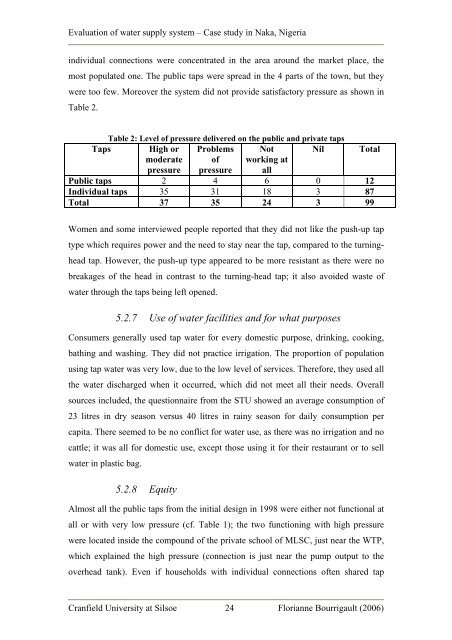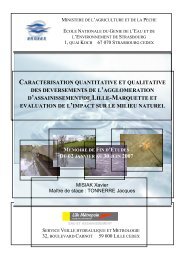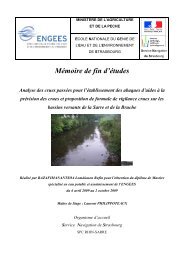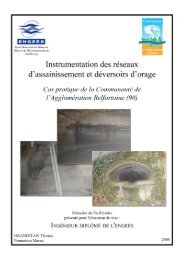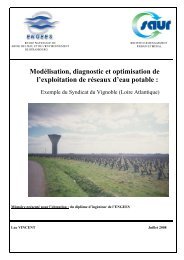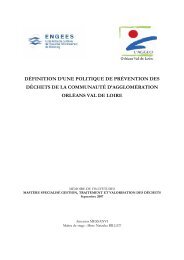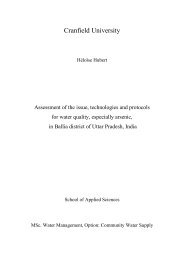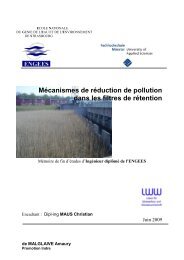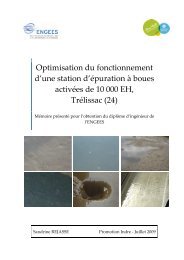Evaluation of water supply system Case study in Naka ... - ENGEES
Evaluation of water supply system Case study in Naka ... - ENGEES
Evaluation of water supply system Case study in Naka ... - ENGEES
- No tags were found...
Create successful ePaper yourself
Turn your PDF publications into a flip-book with our unique Google optimized e-Paper software.
<strong>Evaluation</strong> <strong>of</strong> <strong>water</strong> <strong>supply</strong> <strong>system</strong> – <strong>Case</strong> <strong>study</strong> <strong>in</strong> <strong>Naka</strong>, Nigeria<strong>in</strong>dividual connections were concentrated <strong>in</strong> the area around the market place, themost populated one. The public taps were spread <strong>in</strong> the 4 parts <strong>of</strong> the town, but theywere too few. Moreover the <strong>system</strong> did not provide satisfactory pressure as shown <strong>in</strong>Table 2.Table 2: Level <strong>of</strong> pressure delivered on the public and private tapsTaps High or Problems Not Nil Totalmoderatepressure<strong>of</strong>pressurework<strong>in</strong>g atallPublic taps 2 4 6 0 12Individual taps 35 31 18 3 87Total 37 35 24 3 99Women and some <strong>in</strong>terviewed people reported that they did not like the push-up taptype which requires power and the need to stay near the tap, compared to the turn<strong>in</strong>gheadtap. However, the push-up type appeared to be more resistant as there were nobreakages <strong>of</strong> the head <strong>in</strong> contrast to the turn<strong>in</strong>g-head tap; it also avoided waste <strong>of</strong><strong>water</strong> through the taps be<strong>in</strong>g left opened.5.2.7 Use <strong>of</strong> <strong>water</strong> facilities and for what purposesConsumers generally used tap <strong>water</strong> for every domestic purpose, dr<strong>in</strong>k<strong>in</strong>g, cook<strong>in</strong>g,bath<strong>in</strong>g and wash<strong>in</strong>g. They did not practice irrigation. The proportion <strong>of</strong> populationus<strong>in</strong>g tap <strong>water</strong> was very low, due to the low level <strong>of</strong> services. Therefore, they used allthe <strong>water</strong> discharged when it occurred, which did not meet all their needs. Overallsources <strong>in</strong>cluded, the questionnaire from the STU showed an average consumption <strong>of</strong>23 litres <strong>in</strong> dry season versus 40 litres <strong>in</strong> ra<strong>in</strong>y season for daily consumption percapita. There seemed to be no conflict for <strong>water</strong> use, as there was no irrigation and nocattle; it was all for domestic use, except those us<strong>in</strong>g it for their restaurant or to sell<strong>water</strong> <strong>in</strong> plastic bag.5.2.8 EquityAlmost all the public taps from the <strong>in</strong>itial design <strong>in</strong> 1998 were either not functional atall or with very low pressure (cf. Table 1); the two function<strong>in</strong>g with high pressurewere located <strong>in</strong>side the compound <strong>of</strong> the private school <strong>of</strong> MLSC, just near the WTP,which expla<strong>in</strong>ed the high pressure (connection is just near the pump output to theoverhead tank). Even if households with <strong>in</strong>dividual connections <strong>of</strong>ten shared tapCranfield University at Silsoe 24 Florianne Bourrigault (2006)


